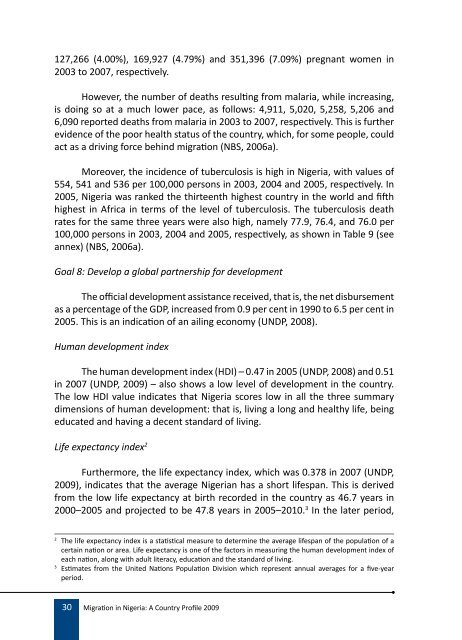Migration Profile on Nigeria - IOM Publications - International ...
Migration Profile on Nigeria - IOM Publications - International ...
Migration Profile on Nigeria - IOM Publications - International ...
Create successful ePaper yourself
Turn your PDF publications into a flip-book with our unique Google optimized e-Paper software.
127,266 (4.00%), 169,927 (4.79%) and 351,396 (7.09%) pregnant women in<br />
2003 to 2007, respectively.<br />
However, the number of deaths resulting from malaria, while increasing,<br />
is doing so at a much lower pace, as follows: 4,911, 5,020, 5,258, 5,206 and<br />
6,090 reported deaths from malaria in 2003 to 2007, respectively. This is further<br />
evidence of the poor health status of the country, which, for some people, could<br />
act as a driving force behind migrati<strong>on</strong> (NBS, 2006a).<br />
Moreover, the incidence of tuberculosis is high in <strong>Nigeria</strong>, with values of<br />
554, 541 and 536 per 100,000 pers<strong>on</strong>s in 2003, 2004 and 2005, respectively. In<br />
2005, <strong>Nigeria</strong> was ranked the thirteenth highest country in the world and fifth<br />
highest in Africa in terms of the level of tuberculosis. The tuberculosis death<br />
rates for the same three years were also high, namely 77.9, 76.4, and 76.0 per<br />
100,000 pers<strong>on</strong>s in 2003, 2004 and 2005, respectively, as shown in Table 9 (see<br />
annex) (NBS, 2006a).<br />
Goal 8: Develop a global partnership for development<br />
The official development assistance received, that is, the net disbursement<br />
as a percentage of the GDP, increased from 0.9 per cent in 1990 to 6.5 per cent in<br />
2005. This is an indicati<strong>on</strong> of an ailing ec<strong>on</strong>omy (UNDP, 2008).<br />
Human development index<br />
The human development index (HDI) – 0.47 in 2005 (UNDP, 2008) and 0.51<br />
in 2007 (UNDP, 2009) – also shows a low level of development in the country.<br />
The low HDI value indicates that <strong>Nigeria</strong> scores low in all the three summary<br />
dimensi<strong>on</strong>s of human development: that is, living a l<strong>on</strong>g and healthy life, being<br />
educated and having a decent standard of living.<br />
Life expectancy index 2<br />
Furthermore, the life expectancy index, which was 0.378 in 2007 (UNDP,<br />
2009), indicates that the average <strong>Nigeria</strong>n has a short lifespan. This is derived<br />
from the low life expectancy at birth recorded in the country as 46.7 years in<br />
2000–2005 and projected to be 47.8 years in 2005–2010. 3 In the later period,<br />
2 The life expectancy index is a statistical measure to determine the average lifespan of the populati<strong>on</strong> of a<br />
certain nati<strong>on</strong> or area. Life expectancy is <strong>on</strong>e of the factors in measuring the human development index of<br />
each nati<strong>on</strong>, al<strong>on</strong>g with adult literacy, educati<strong>on</strong> and the standard of living.<br />
3 Estimates from the United Nati<strong>on</strong>s Populati<strong>on</strong> Divisi<strong>on</strong> which represent annual averages for a five-year<br />
period.<br />
30 <str<strong>on</strong>g>Migrati<strong>on</strong></str<strong>on</strong>g> in <strong>Nigeria</strong>: A Country <str<strong>on</strong>g>Profile</str<strong>on</strong>g> 2009

















